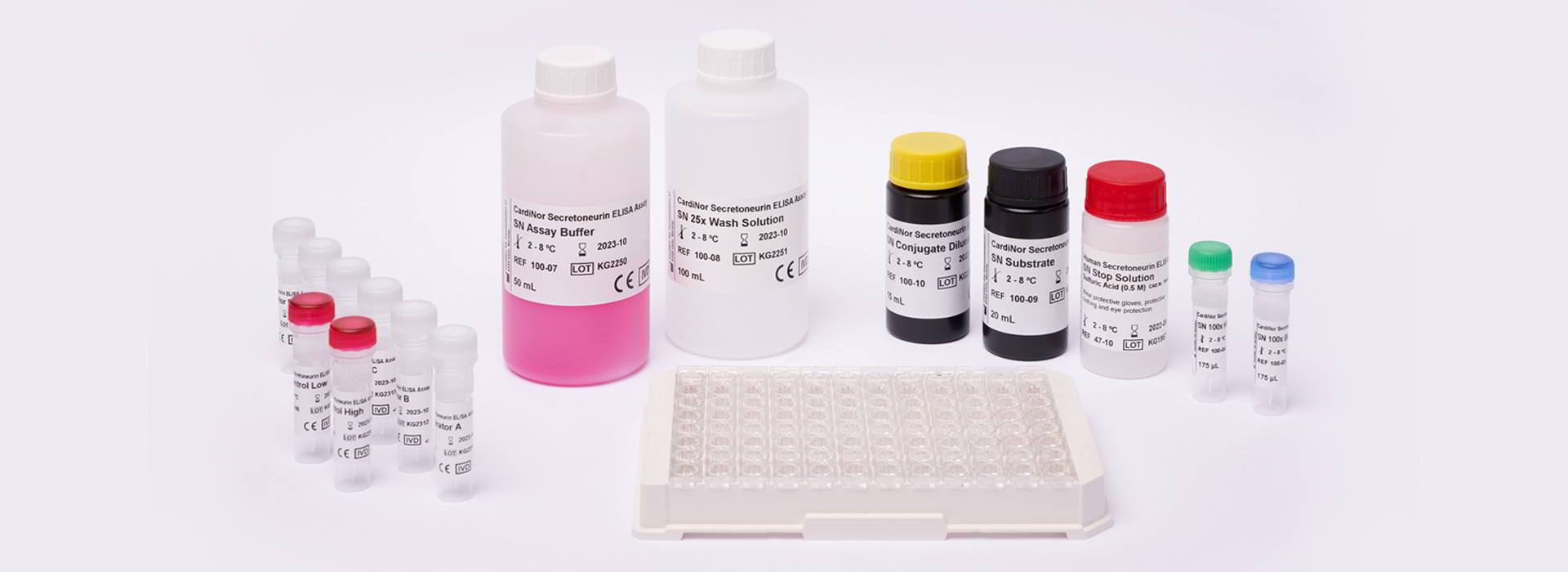
CardiNor Secretoneurin
CardiNor Secretoneurin ELISA
CardiNor have developed a secretoneurin ELISA (Enzyme-linked immunosorbent assay) based on two secretoneurin-specific monoclonal antibodies (MABs) from sheep. One MAB is biotinylated and the second is HRP-conjugated. The biotinylated antibody is added to the wells of a streptavidin coated microtitre plate. After washing, diluted calibrators, controls and samples are added, and secretoneurin present is bound to the immobilised antibody. After incubation of samples the wells are washed to remove unbound sample material, and the HRP-conjugated antibody is added. After incubation and wash, the TMB substrate is added. The blue colour developed is directly proportional to the amount of secretoneurin present in the calibrators, controls, and samples. The stop solution changes the colour from blue to yellow, and the intensity of the colour is measured in a microtitre plate reader.
The CardiNor Secretoneurin ELISA kit includes 6 calibrators and high and low controls.
Analytical performance of the CardiNor Secretoneurin ELISA
| Limit of Quantification (LoQ) | 7.6 pmol/L |
| Limit of Detection (LoD) | 5.1 pmol/L |
| Linearity | 11.8 – 299.2 pmol/L |
| Repeatability | 2.7 – 4.6 % CV |
| Hook effect | No falsely low SN results observed for serum samples up to 5000 pmol/L |
What is secretoneurin (SN)
Secretoneurin is a 33-amino acid neuropeptide and the biological active fragment of secretogranin II1 (SgII), a protein in the granin family2. SN is produced by neuroendocrine and heart muscle cells by endoproteolytic cleavage of SgII. Secretoneurin is detectable in the blood stream.
Secretoneurin presents as an independent and strong predictor of mortality in several patient cohorts, including ventricular arrhythmia, acute heart failure, acute respiratory failure patients with CVD and severe sepsis. Importantly, secretoneurin seems to provide prognostic information independent of currently used cardiac biomarkers and one could therefore envision secretoneurin as part of a biomarker panel together with cardiac troponin and BNP.
Cardiomyocyte Ca2+ imbalance is at the core of most triggered arrhythmias in CVD, but current biomarkers (troponins and BNP) do not reflect Ca2+ regulation. As the only biomarker associated with Ca2+ status, secretoneurin is ideally suited for this purpose. Moreover, high secretoneurin concentrations are also a strong indication of the need to follow up with ECGs, echocardiography, and other examinations (angiography, cardiac MRI, PET-CT, etc.) to determine whether there are signs of structural or functional heart disease.
SN is thus addressing a vast and untapped market potential for CVD patient prognosis, risk stratification and monitoring, complementary to BNP/NT-proBNP and cardiac troponins.
